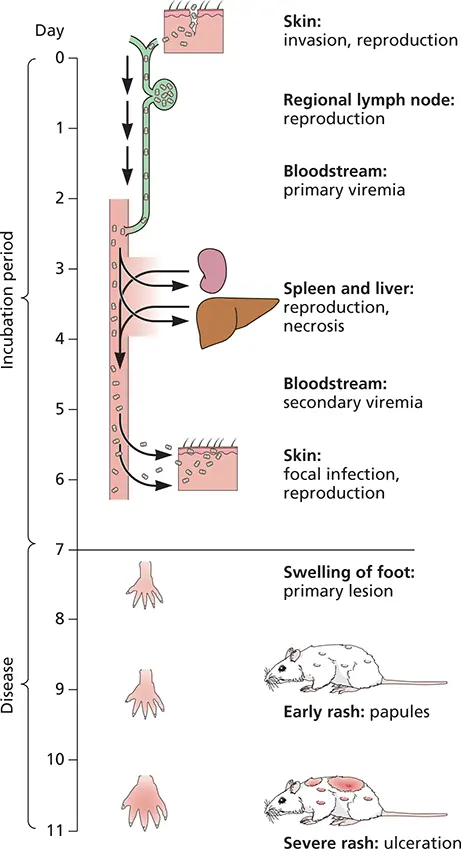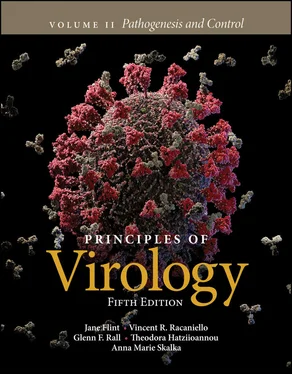S. Jane Flint - Principles of Virology, Volume 2
Здесь есть возможность читать онлайн «S. Jane Flint - Principles of Virology, Volume 2» — ознакомительный отрывок электронной книги совершенно бесплатно, а после прочтения отрывка купить полную версию. В некоторых случаях можно слушать аудио, скачать через торрент в формате fb2 и присутствует краткое содержание. Жанр: unrecognised, на английском языке. Описание произведения, (предисловие) а так же отзывы посетителей доступны на портале библиотеки ЛибКат.
- Название:Principles of Virology, Volume 2
- Автор:
- Жанр:
- Год:неизвестен
- ISBN:нет данных
- Рейтинг книги:3 / 5. Голосов: 1
-
Избранное:Добавить в избранное
- Отзывы:
-
Ваша оценка:
- 60
- 1
- 2
- 3
- 4
- 5
Principles of Virology, Volume 2: краткое содержание, описание и аннотация
Предлагаем к чтению аннотацию, описание, краткое содержание или предисловие (зависит от того, что написал сам автор книги «Principles of Virology, Volume 2»). Если вы не нашли необходимую информацию о книге — напишите в комментариях, мы постараемся отыскать её.
Volume I: Molecular Biology
Volume II: Pathogenesis and Control
Principles of Virology, Fifth Edition
Principles of Virology, Volume 2 — читать онлайн ознакомительный отрывок
Ниже представлен текст книги, разбитый по страницам. Система сохранения места последней прочитанной страницы, позволяет с удобством читать онлайн бесплатно книгу «Principles of Virology, Volume 2», без необходимости каждый раз заново искать на чём Вы остановились. Поставьте закладку, и сможете в любой момент перейти на страницу, на которой закончили чтение.
Интервал:
Закладка:
Effective transmission of virus particles from one host to another depends on the site of shedding and the concentration of released particles.
Viral transmission to a new host usually occurs through body fluids, including respiratory aerosols and secretions, blood, saliva, semen, urine, and milk.
BOX 2.1
TERMINOLOGY
Is it evasion or modulation?
From the online Merriam-Webster Dictionary :
Evade: to elude by dexterity
Modulate: to adjust to or keep in proper measure or proportion
The phrase “immune evasion” pervades the virology literature. It is intended to describe the viral mechanisms that thwart host immune defense systems. However, this phrase is imprecise and even misleading. The term “evasion” implies that host defenses are ineffective, similar to a bank robber evading capture by a hapless police force. In reality, a virus does not necessarily need to be invisible to the host response throughout its reproduction cycle; it simply must delay or defer detection for a time sufficient to produce progeny virus particles. If viruses really could evade the immune system, we might not be here discussing such semantic issues.
Perhaps a more accurate term to describe viral gene products that delay or frustrate host defenses is “immune modulators.” The principle is that, given the speed of viral reproduction, an infection can be successful even if host defenses are suppressed only transiently or partially.

From the moment of ectromelia virus entry, the host mounts a response to counteract the virus. The impact of such countermeasures is revealed by the effects of specific immune deficiencies, which lead to different kinds of disease. If the mouse lacks CD8 +T lymphocytes, a major immune cell population critical for destroying virus-infected cells, it will die of extensive liver destruction by 4 to 5 days after infection. If instead the host lacks the potent antiviral cytokine interferon gamma, the virus may be controlled in the liver, even though death will occur by 10 to 12 days after infection as a consequence of uncontrolled viral reproduction in the skin. Even in mice with intact immune responses, viral movement from tissue to tissue means that the immune response is continually playing catch-up: as infection is controlled in the liver, infection of the skin appears. Furthermore, while mice of a certain strain can control the infection and survive, mice of a different strain may not, underscoring the critical involvement of more subtle genetic regulators of immune control.
Just as ectromelia advances through various permissive tissues of the host, the host defenses are deployed in a coordinated, stepwise manner ( Fig. 2.2). All surfaces of the mammalian body where pathogens may enter are protected by defensive layers provided by fur, skin, and mucus, or are acidic environments. Once these barriers are crossed and cells become infected, intrinsic cellular defensesincluding cell-autonomous responses, such as autophagy and cell suicide, are engaged. Because the virus may reproduce faster than an infected cell can control it, the “professional” immune response is also induced, beginning with the early innate response( Chapter 3). Eventually, virus-specific cells of the adaptive responsearrive at the site of infection, targeting infected cells and extracellular virus particles for destruction or elimination ( Chapter 4).
While this text generally avoids imparting actions to viruses, the impression one may have gained from the ectromelia virus example is that viruses are on a seemingly preordained, step-by-step path to gain access to their target cells of choice (for example, hepatitis viruses in hepatocytes, measles virus in epithelia, or human immunodeficiency virus type 1 in CD4 +T cells). Likewise, one might think that the immune response is deployed in a synchronized and choreographed manner, much like actors performing a play night after night. These impressions would be wrong. As every game of chess is constrained by the same rules, but each game differs in execution and outcome, so too are viral infections and host immunity influenced by random, or stochastic, events. For example, tissues and the immune system may impose bottlenecks on the dissemination of a virus population. The diversity of viral populations enables some particles to pass through the bottleneck, while others are lost as the virus spreads ( Chapter 10). Such bottlenecks include not only access to tissues but also immune restriction ( Fig. 2.3). The stochastic view does not reject the idea that infections generally follow a predictable course, but rather adds random elements to the consequences of each step that could affect the speed of viral transmission throughout the host, the immunological control of the virus, or the magnitude of illness experienced by the infected host.

Figure 2.1 Ectromelia virus infection of mice. Infection begins with a break in the skin, allowing the virus to access susceptible and permissive cells, with ensuing local viral reproduction and dissemination via the lymphatics within 1 to 2 days of exposure. Experimentally, virus can be injected into the footpad. Primary viremia occurs when the virus is released into the bloodstream, permitting infection of the spleen, liver, and other organs, greatly amplifying the number of viral particles within the host. Secondary viremia occurs as a consequence of release of virus from these organs, resulting in infection of distal sites of the skin. In certain inbred strains, as well as in wild mice, a severe rash may develop. Adapted from Fenner F et al. 1974. The Biology of Animal Viruses (Academic Press, New York, NY), with permission.
Initiating an Infection
Three requirements must be met to ensure successful infection of an individual host: a sufficient number of infectious virus particles must be available to initiate infection; the cells at the site of infection must be physically accessible to the virus, susceptible(bear receptors for entry),and permissive(contain intracellular gene products needed for viral reproduction);and local antiviral defenses must be absent or, at least initially, quiescent.
The first requirement imposes a substantial barrier to any infection and represents a significant limitation in the transmission of virus from host to host. Free virus particles face both a harsh environment and rapid dilution that can reduce their concentration. To remain infectious, viruses that are spread in contaminated water and sewage must remain stable in the presence of osmotic shock, pH changes, and sunlight. Aerosol-dispersed virus particles must remain hydrated and sufficiently concentrated to infect the next host. These requirements account for why respiratory viruses spread most successfully in populations in which individuals are in close contact and in which the time that a virus particle is outside of a host is minimized. In contrast, viruses that are spread by biting insects, contact with mucosal surfaces, or other means of direct contact, including contaminated needles, have little or no environmental exposure; the virus is transmitted directly, for example, from mosquito to human.
Even after transmission from one host to another, infection may fail simply because the concentration of infectious virus particles is too low. For example, in principle, a single West Nile virion delivered by an infected mosquito should be able to initiate an infection, but host physical and immune defenses, coupled with the complexity of the infection process itself, usually require the presence of many infectious particles for an infection to begin. In the case of West Nile virus, the inoculum may not gain access to the bloodstream, or blood-borne proteins may degrade or otherwise prevent infection of target cells. One can envision many paths to failure: the virus particle may adhere to a dead or dying cell, become attached to nonsusceptible cells by nonspecific protein-protein interactions, be swept away in the bloodstream, get stuck in mucus, or be degraded within a lysosome upon entry into a target cell.
Читать дальшеИнтервал:
Закладка:
Похожие книги на «Principles of Virology, Volume 2»
Представляем Вашему вниманию похожие книги на «Principles of Virology, Volume 2» списком для выбора. Мы отобрали схожую по названию и смыслу литературу в надежде предоставить читателям больше вариантов отыскать новые, интересные, ещё непрочитанные произведения.
Обсуждение, отзывы о книге «Principles of Virology, Volume 2» и просто собственные мнения читателей. Оставьте ваши комментарии, напишите, что Вы думаете о произведении, его смысле или главных героях. Укажите что конкретно понравилось, а что нет, и почему Вы так считаете.



